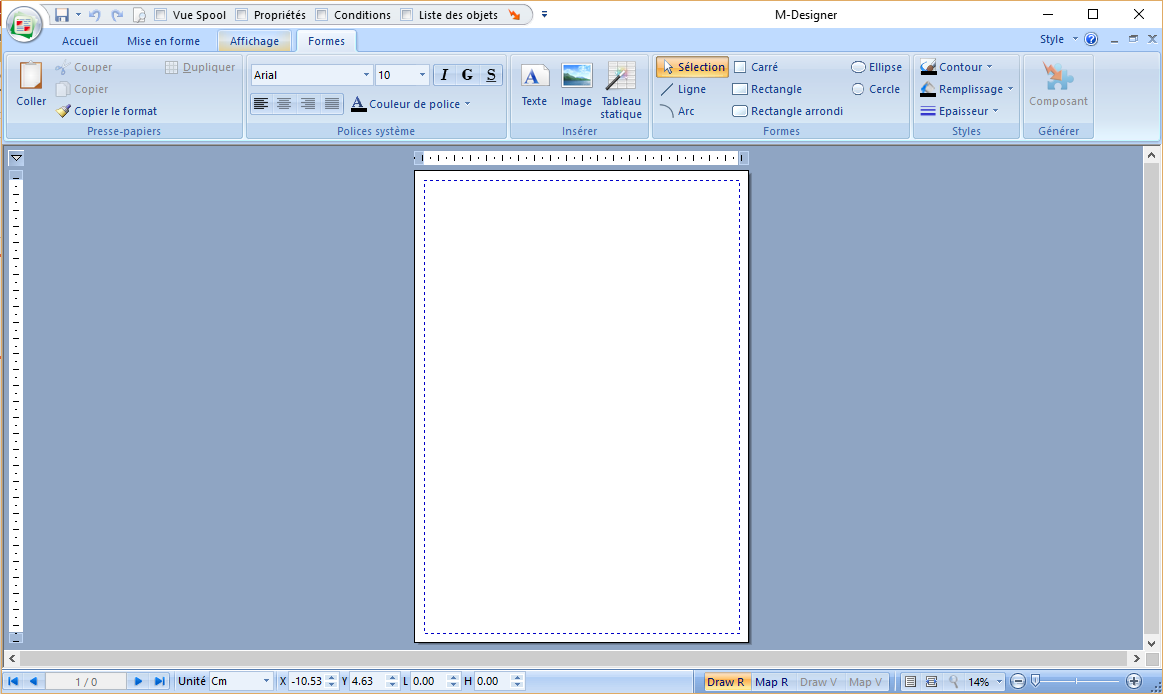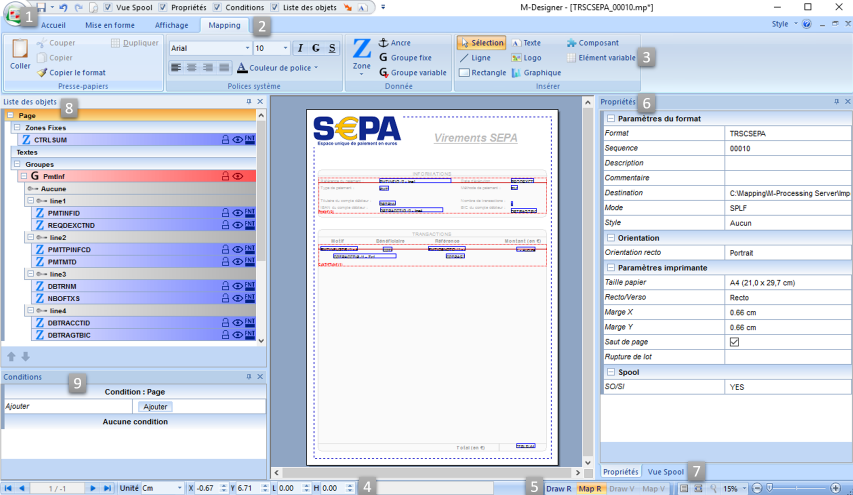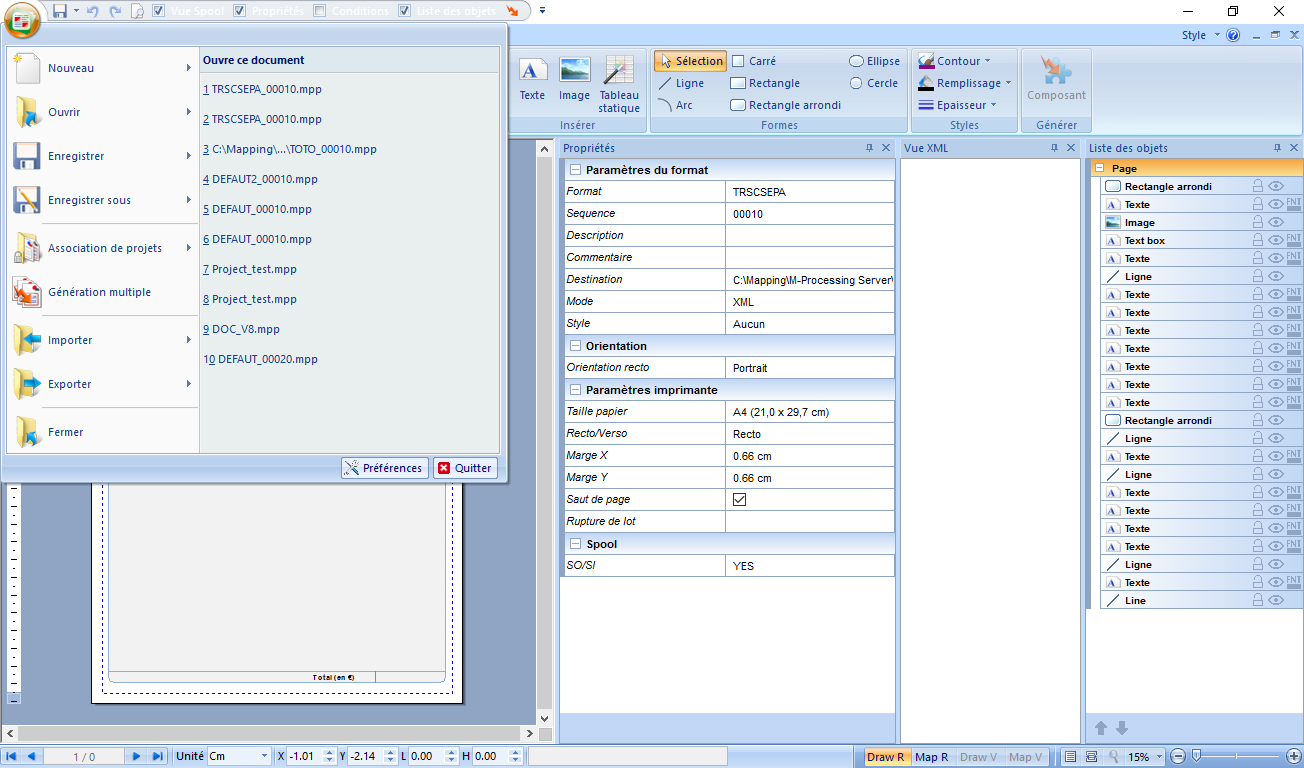ONYX - 9.0 - Utilisation
Interface of the ONYX Designer application
Sommaire
Interface of the application
General presentation
When using Designer for the first time, only the overlay designing view is displayed. This simple display mode allows you to only activate the windows you need.
Window activation is explained in 3.2.a File menu.
The following image shows an overview of the Designer user interface. In this example, the Spooled File View, Properties, Conditions and Object Tree windows are activated.
It is divided in several parts:
- 1: File Menu
- 2: Tabs in the Ribbon
- 3: Groups of tools associated with each tab of the Ribbon
- 4: Status bar with the tools used to position and size objects
- 5: Navigation between the static and the variable parts of a project + display zoom tools
The Designing Space where templates are designed is found between the menus and tools displayed at the top of the window and the status bar located at the bottom.
This design space can also be made up of several views, in addition to the central Designing view:
- 6: Properties View: of the format, of an object selected in the template
- 7: Spooled file View: included in the same display space as the Properties, multiple tabs are now available.
- 8: Object Tree View list of all the objects in the template (static and variable parts)
- 9: Conditions View: of the format, of a selected object.
The display positions of each view can be configured according to the user preferences and habits. To do so, hold the button of your mouse down when clicking on the title of the View, then drag the mouse to the required display area or on an already positioned view, a display space with several views is now shown.
Menus and associated toolbars
This part introduces you to the different menus and options available within them, in the Designer interface. Each notion will be further detailed in the following parts.
File Menu
New:
- Project: creates a new project with default properties (DEFAULT format, sequence 00010, in A4, simplex).
- Component: creates a new component with default properties (A4, simplex).
- Variable element: creates a new variable element with default properties (A4 simplex).
- Document: creates a new Overlay document (.mpw) or Dynamic document (.mpi) according to the selected view (Draw F or Map F). This overwrites the current document.
Open:
- Project: opens an existing project by browsing file paths. The folder selected by default depends on the Server preferences of the application.
- Component: opens an existing component.
- Variable Element: opens an existing variable element.
- Document: opens an existing Overlay (.mpw) or a Dynamic document (.mpi), according to the selected view (Draw F or Map F). This overwrites the current document.
- Spooled File: used to select a spooled file to load in the application as a designing data template.
Save:
- Project: saves the curent project. Source files of the project will be saved, N-1 versions may also be saved according to user preferences.
- Document: saves the current Overlay (.mpw) or Dynamic document (.mpi), according to the view displayed (Draw F or Map F).
Save as:
- Project: saves the current project under an other name. Source files of the project will be saved under the new names given by the user.
- Document: saves the current document (.mpw or .mpi) under an other name.
Project association:
- Links several projects to make their generation easier. A project association creates a settings file on the disk, with a *.mpa extension, in which the projects concerned and the generation options are listed.
Multiple generation:
- Selects multiple Designer projects to generate them all at once.
Import:
- Designer file: imports another existing Designer overlay such as a component, or the static part of another project, in the static part of the current project.
- XML Designer: imports an entire Designer project in the application, after it was exported to XML. This imports the XML file as a new project, retrieving all its properties and design.
- Resources: imports an eternal resource as overlay of a new project, in the application. Resources can either be XPS documents or AFPDS overlays.
Export:
- Printer (PCL5): prints the overlay of the current project on a printer known on the workstation.
- Project: selects one or several projects to export in an archive (.zip) with the potential associated spooled files.
- XML Designer: exports the entirety of the current project in an XML description file. All properties and designs of the project are found in the resulting file which will then be imported in an other instance of the application on an other workstation for instance.
Close:
- Closes the current project or document and detects unsaved changes.
Preferences:
- See 2.1 General.
Home Menu
The Home menu gives access to the general options of the project or document being created:
Clipboard:
- Cut/ copy/ paste one or several elements selected in the project (standard keyboard shortcuts Ctrl+X, Ctrl+C and Ctrl+V are also available)
- Copy the formatting of an element onto others (texts or shapes)
- Duplicate a selected element and set the required number of horizontal and vertical occurrences (this is useful when creating sheets of labels for instance).
System fonts:
- Text standard formatting: choose the TTF system fonts available on the workstation (Windows), the size, colour, bold/ underlined/ italic, justified or aligned.
Generate:
- Generate the project being created. This option is only available for projects being created (opened in the application).
- Generate an existing project association.
- Export overlay (see the File Menu part).
- Access the script utility in the Designer application.
Preview:
- Preview project currently being created.
- Select and load a spooled file in the application (this is useful when designing a document and previewing it).
- Multiple preview for multi sequence projects.
- Save an image of the preview.
- Load an XPS file as a layer (not included in the generation but displayed in the design as a pre-printed form).
- Unlink the source file (spooled file) to the template and close it.
- Carry out processings on XML input file using scripts.
Edit Menu
The Edit menu gives access to designing options of the current project or document:
In addition to the Clipboard and Font system sections, the following tools are also available in this menu:
Sort:
- Applied to one or several selected elements, sorting can bring them to the front or to back, manage alignments and rotations. These options can also be accessed by right clicking on the selected elements and further detail will be given in the following parts of this documentation.
Position according to grid:
- To help with designing, a grid can be displayed to make positioning elements easier for the user. The two options of this section help to adjust the spacing of the grid (size of the grid and thus the precision of element positioning) and snap objects to the grid while they are moved.
Display Menu
The Display menu gives access to display options of the different views of the application:
Show/Hide:
Given that none of these options are activated when opening the software for the first time, the functions which are most suitable for the basic use of Designer will be marked with the term (recommended).
- Grid: displays the grid in the designing view.
- Top/Left Ruler: displays the top and left hand rulers of the designing view. It is possible to place guides in these rulers in order to align objects more easily. A Left click on the ruler places and collapses a rule-guide. A Right click on an existing rule-guide deletes it.
- Spooled file view: displays the loading view of the example spooled file (or XML file) (recommended).
- Properties : displays the properties view of the project and elements (recommended).
- Conditions: displays the conditions view (recommended whenever the design work deals with a dynamic part).
- Object Tree: displays the list of all the elements positioned in the document template, some features related to the elements can also be accessed.
- Tab bar: displays the tab navigation bar for the different projects opened in the application.
Characters list:
- Lists all the characters supported by the application according to a code page and font. This can be useful to insert special characters, which cannot be directly typed in, in a document.
Refresh:
- Refreshes the screen.
Windows:
This helps you manage the many windows of your projects opened in the application. It allows you to activate, save or close some of them or all of them all at once.
Shape Menu
This menu features all the drawing and composition tools for your document template. This menu is arranged differently depending on the part of the project concerned, the overlay part (static) or the dynamic part (variable).
Shape Menu of the Overlay (or Static)
Outre les sections Presse papier et Polices système, reprises dans ce menu, les outils suivants sont proposés pour la conception du fond de page :
Insérer :
- Ajouter et positionner une zone contenant du texte statique avec toutes les options de mise en forme associées.
- Ajouter et positionner une image statique (comme un logo société par exemple).
- Ajouter, paramétrer et positionner un tableau statique en définissant le nombre de lignes et de colonnes, les styles de traits et leurs mises en forme, les entêtes de lignes / colonnes, …
Formes :
- Palette standard de dessin permettant d’ajouter des lignes, courbes, carrés, rectangles, rectangles arrondis, cercles, ellipses, ainsi que certaines formes complexes prédéfinies.
Styles :
- Options de mises en forme associées à chacun des éléments précédents : style et couleur de contours, style et couleur de remplissage, épaisseur des traits.
Générer :
- Option spécifique à la conception d’un composant permettant de générer ce dernier.
Menu Forme de la vue Dynamique
Outre les sections Presse papier et Polices système, reprises dans ce menu, les outils suivants sont proposés pour la conception dynamique du document :
Donnée :
Ce groupe d'outils rassemble les utilitaires nécessaires au traitement des données du fichier source (spool). Il est composé de deux types d'outils :
Groupe :
- Permet d’ajouter, de paramétrer et de positionner des groupes de données : groupe fixe et groupe variable.
- Permet également d’ajouter des ancres utilisées pour le positionnement des groupes variables.
Zone :
- Permet d’ajouter, de paramétrer et de positionner des zones de récupération de données.
Insérer :
- Permet d’insérer, en plus des données du fichier Spool, d’autres éléments dynamiques : lignes droites, rectangles, zones de texte saisi au clavier, images dynamiques, graphiques...
- Permet également d’ajouter dans le projet des composants et/ou des éléments variables conçus par ailleurs.
Barre d'outils « Accès Rapide »
La barre de titre de l’application propose enfin une barre de raccourcis, ou barre d’outils, appelée Accès rapide:
Les outils et fonctions accessibles dans cette zone sont complètement paramétrables en fonction des habitudes de chaque utilisateur.
Pour ajouter une fonction dans la zone d’accès rapide, il suffit de localiser la fonction en question dans les différents menus puis par un clic droit, il faudra sélectionner Ajouter à la barre d’outils Accès rapidecomme montré ci-après :
La nouvelle fonction apparaît alors dans la barre de titre :
Pour supprimer une fonction de la zone d’accès rapide, il suffit de cliquer dessus avec le bouton droit puis de sélectionner Supprimer de la barre d’outils Accès rapide.
Le menu déroulant à droite de la zone des fonctions rapides permet, par l’option Personnaliser la barre d’outils Accès rapide, de personnaliser les fonctions accessibles ainsi que leur disposition (ordre d’affichage, ajout de séparateurs) :










